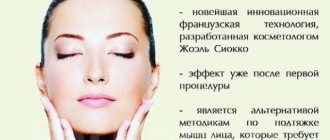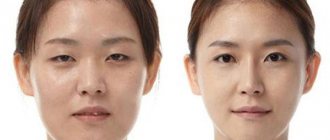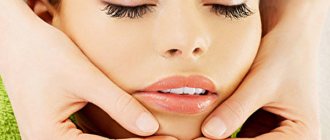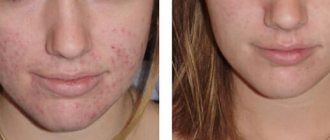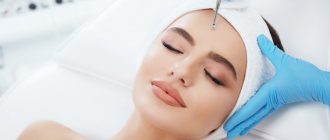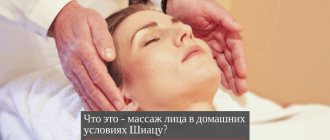How is facial massage beneficial and what signs of age can be eliminated or smoothed out using this procedure?
Before answering this question, I would like to talk about age-related changes in the face and neck area, which entail external signs of aging.
Part 1. Why we look worse as we age
- Age-related skin changes are just the tip of the iceberg
- Age-related changes in the skull
- Hypertonicity of the muscles of the face and neck
Part 2. Why massage is useful and basic rules
- Benefits of massage
- At what age can you do facial massage?
- Contraindications to facial massage
- Duration of effect
- How often should you massage your face?
- How long should a massage last?
Part 3. Massage techniques
- Basic facial massage techniques
- More effective techniques
- Individual schemes
Part 4. How to choose a massage therapist for facial massage
- Based on personal recommendations
- Nice man
- Effect after the first procedure
- Try different specialists
Part 5. Myths about massage
- Massage stretches facial skin
- I don’t see any effect from the massage
- Facial massage is a useless procedure
- Massage gives only relaxation and nothing more
- Massage is a panacea for all problems
Answers on questions:
- Facial massage for rosacea and rosacea
- Massage and Botox injections
- Acne after facial massage
- Massage and nasolabial folds
Why do we look worse as we age?
Age-related skin changes are just the tip of the iceberg
Often, noticing wrinkles, folds or a swollen oval face in the mirror, women believe that the skin is to blame. And therefore they begin to intensively care for the skin of the face and neck:
- buy anti-wrinkle creams,
- anti-aging serums,
- make masks
- peelings,
- mesotherapy
- and other home and salon skin care treatments.
Of course, our skin is subject to both chrono- and photoaging, so with age it really requires more and more care. But the signs of aging that we see on the skin of the face and neck are just the tip of the iceberg.
In fact, the appearance of wrinkles, folds or swelling is associated not only with skin aging, but also with age-related changes in the bones of the skull, our muscles and blood vessels. It’s just that these changes are hidden from our eyes, and therefore we often do not give them due importance.
But in order for anti-aging care to be adequate and as effective as possible, you need to know and remember about these changes.
Age-related changes in the skull
First of all, it should be noted that throughout life our skull deforms and decreases in volume, and after this our face changes.
However, while our muscles are young and elastic, they tend to tightly grip the changing skull, and healthy elastic skin follows the muscles. Therefore, at 30 years old, our face no longer looks the same as it did at 20, but, as a rule, there are no obvious signs of aging yet.
But the older we get, the more our bones dry out and the skull decreases in volume, and the facial muscles weaken, lose volume, elasticity and can no longer grip our skull as tightly as before.
And since the facial muscles are woven into the skin at one end, where the facial muscles sag, our skin sag.
Hypertonicity of the muscles of the face and neck
But in addition to the fact that some muscles weaken with age and begin to sag, that is, they are in hypotonicity, other muscles are often in hypertonicity, for example, the muscles of the forehead or neck. Hypertonicity is excessive muscle tension.
Many people now lead a sedentary lifestyle - they work all day at the computer, or spend a lot of time driving, and in the evening they often relax again at the computer, for example, watching videos on YouTube.
All this contributes to hypertonicity of the neck muscles.
And many of you probably know that when the neck muscles are overstrained, they compress the blood vessels, which disrupts the blood supply to the brain:
- headaches appear
- attention decreases
- memory deteriorates,
- sleep is disturbed.
In general, our health and well-being suffers. But perhaps not everyone knows that the beauty of our face largely depends on the condition of the neck muscles.
When blood flow is disrupted, our skin cells receive less nutrients and oxygen, and as a result, the skin ages faster .
In addition, due to muscle hypertonicity, venous outflow and lymph outflow are disrupted, which contributes to the appearance of edema and other problems. The face becomes pasty (that is, puffy, as if wrinkled), the oval floats, and a double chin is formed.
Hypertonicity of certain facial muscles, for example, the forehead muscles, contributes to the appearance of wrinkles and folds in this area.
Massage lines for face and neck
The main rule that must be followed in order not to cause harm when performing a classic facial massage: “Move along the massage lines!”
Massage lines are vectors along which the skin resists stretching three times stronger than along others. If you massage your face and neck taking them into account, the skin will not stretch or sag.
It is not difficult to remember massage lines.
- Basically, they go from the center of the face to the periphery - this is how we move along the forehead, cheeks, lower jaw
- We massage the upper eyelid according to the same principle (from the inner corner of the eye to the outer), and the lower - vice versa (from the outer to the inner).
- We walk along the nose from bottom to top.
- The neck has its own directions. Along its front part we move from bottom to top, and along its side – from top to bottom.
Benefits of massage and basic rules
Benefits of massage
Fortunately, our muscles are capable of self-rejuvenation. You know very well that if you train skeletal muscles - the muscles of our body, then at almost any age they will become denser and more elastic, and the body will become more toned.
Facial muscles are no exception.
It is no coincidence that massage is called passive gymnastics. With a massage of the face, neck and décolleté, you can relax tense muscles and tone weakened ones. As a result, the oval of the face will be tightened, folds and wrinkles will be smoothed out or reduced.
In addition, during the massage, blood circulation improves - the flow of arterial blood increases and skin cells receive more nutrients and oxygen.
As a result, complexion and skin turgor improve, and the aging process slows down. By improving the outflow of venous blood and lymph, facial massage helps eliminate swelling and has a lifting effect.
And of course, massage affects the nervous system - it relieves emotional tension and other consequences of stress.
Endorphins are produced - hormones of joy, happiness and pleasure. It lifts your mood, improves sleep and overall well-being.
As for me, I can directly say: massage is my favorite salon procedure .
I love both enjoying a good massage myself and giving massages to my clients, learning new massage techniques and incorporating them into various care programs.
That is why I developed my own “Renaissance” facial self-massage technique.
At what age can you do facial massage?
Facial massage can be done at any age. But up to 25 years of age, massage is usually done if indicated. For example, if there is swelling or nervous tension.
At 25-30 years old, massage can be done in a short course to prevent aging. And from the age of 30, it is advisable to regularly include massage in your salon anti-aging care.
Contraindications to facial massage
What are the contraindications to facial massage? Fever, colds. Various skin rashes - exacerbation of acne, herpes, allergic reactions. Any damage to the skin - wounds, abrasions, scratches.
In this case, you just need to wait until the exacerbation passes.
Some diseases of the cardiovascular system, cancer and other serious health problems are also contraindications.
Duration of effect
Here again it would be appropriate to compare massage with fitness classes. If you only went to one workout, then for 3-4 days you will feel muscle tone, but then these sensations will fade away.
If you have been regularly engaged in fitness for some time and have achieved good shape, then even if you stop exercising, your muscles will still be elastic and your figure toned for several months. However, over time, if you don't exercise, you will lose your former shape.
The situation with facial massage is very similar.
If the massage is performed as a one-time procedure, the effect will last about 3-4 days, and then fade away. From a good massage after the first session:
- Swelling will decrease
- Improved complexion
- Eyes will open
- The oval will tighten
That is, going to a banquet, an important date or a meeting of classmates - the effect will be enough.
But in order to achieve a lasting result, you need to undergo a course of 10-15 procedures, and in the future it is advisable to periodically do maintenance massage sessions. Or repeat the course in a few months.
How often should you massage your face?
On average, it is recommended to undergo an intensive massage course 2 times a year - 10-15 procedures 2-3 times a week. And to maintain the achieved result, it is advisable to do maintenance massage sessions at least 1-2 times a month.
But of course, these are very average and generalized recommendations. In real life there should be an individual trip.
At the age of 25-30 years, if there are no special problems, perhaps half a course of 5-7 procedures will be enough and someday you will visit a cosmetologist for a maintenance session.
And after 40 years, you will most likely need at least 10-15 procedures to achieve maximum effect, and maintenance sessions at this age should be regular.
Well, of course, you need to take into account a person’s lifestyle. For example, someone can visit the salon only once a week on their day off, while others are constantly on the road, and such people need an individual approach.
How long should a massage last?
How long a facial massage should last from a good specialist depends not on the qualifications of the specialist, but on the massage technique.
Because there are techniques, for example, therapeutic massage according to Jacquet, which lasts from 10 to 20 minutes. And there are massages that last from an hour to an hour and a half.
But on average, a massage of the face, neck and décolleté usually lasts from 30 minutes to 1 hour.
That is, 30-40-45 minutes is, in my opinion, the best option. Because if the massage lasts more than an hour, then some people start to get tired of the massage. But if a person likes it and is ready for a 1.5 hour massage, then this is also possible.
Indications for use - when you need to do a classic massage
- Decreased skin tone - a feeling of thinness, flabbyness, fatigue, dull color.
- Equally, dryness or swelling of the skin - both are usually associated with disturbances in the circulation of natural body fluids, and classical massage normalizes them. Seven troubles - one answer.
- Expression wrinkles - correcting the tone of the skin and facial muscles can smooth them out or at least reduce their severity before the changes take hold.
- Just prevention of change. This is a truly broad indication - strictly speaking, it is suitable for every person who would not want his face to start aging before he does.
Which massage to choose
Basic facial massage techniques
If you are puzzled by this question, you will find on the Internet that there are a huge number of different massage techniques. And perhaps it will become completely unclear what kind of massage you need?
But if you look into beauty salons, you will most often find three types of massage in the list of services:
- Classical
- Plastic
- Therapeutic massage according to Jacquet
The fact is that these three massages are included in the training program in almost all cosmetologist courses in the post-Soviet space. And if you live in Europe or America, then classic massage can be found there under the name Swedish massage.
More effective techniques
I don't want to say anything bad about these massages, classics are classics. And if you have the opportunity to do only this type of massage, that’s also good.
But massage also does not stand still - it is developing, improving, and now there are new, more effective massage techniques.
Why more effective?
Classic or plastic massage is a set of movements that are repeated one after another. That is, by and large, this is a clear scheme - the same for everyone, regardless of age, type of aging and the severity of any problems.
That is, in this case, massage has a general effect on the lymphatic, circulatory, muscular and nervous systems. But there are techniques that are aimed at working through certain problems.
For example, lymphatic drainage massage, where the emphasis is on the lymphatic system, which makes it possible to more effectively fight swelling, eliminate bags under the eyes and tighten the oval of the face, or muscular-structural massage, where the emphasis is on working with the muscles of the face and neck.
Individual schemes
And there is another important point - our body very quickly adapts to the same type of influence, and after 4-5 procedures a plateau effect may occur - when progress stops.
The plateau effect occurs when playing sports, when losing weight, and massage is no exception.
But there are modern techniques that make it possible to create individual schemes for each client - depending on age, type of aging and the presence of certain problems.
And you can change these patterns from session to session, which allows you to avoid the plateau effect and make each massage session as effective as possible .
For example, my “Renaissance” facial self-massage technique includes 15 techniques. And among them there are both lymphatic drainage techniques and techniques that work the muscles of the face and neck.
This variety of techniques allows you to create individual schemes for specific problems and types of aging.
Absolute contraindications
If there are contraindications from the list below, massage is harmful, as it increases blood circulation and lymph flow, which will only harm the body
Massage taboo:
- — Flu, ARVI, tonsillitis, any acute inflammatory processes
- — Blood diseases, internal bleeding
- — Malignant neoplasms and tumors
- — Purulent processes of any localization
- — Scurvy
- — Osteomyelitis
- — Complicated forms of varicose veins: thrombosis, thrombophlebitis and trophic ulcers, any acute inflammation of blood and lymphatic vessels
- — Aneurysm of the aorta and heart, acute myocardial ischemia
- — Pulmonary heart failure of the third degree
- — Hyper- and hypotonic crisis
- — Diseases of the abdominal organs with a tendency to bleeding
- — Active form of tuberculosis
- — Kidney and liver failure
- - Venereal diseases
- - Mental illness with excessive agitation and significantly altered psyche.
More detailed information is in the following video:
How to choose a massage therapist for facial massage
Based on personal recommendations
I see two ways. The first way is to use the experience of your friends, and the second is to look for a specialist yourself through trial and error.
Of course, the first way is preferable, so I would advise you to first ask your friends, perhaps some already visit a cosmetologist regularly, get massages, have been to different specialists and they have something to compare with.
And perhaps they will recommend a good massage therapist to you too. And if you don’t have such friends, then you’ll have to look for a specialist yourself. I can only give a few tips on what you should pay attention to when choosing a specialist.
Nice man
First of all, I would like to say that massage is a rather intimate procedure.
Because if during hardware techniques the massage therapist has virtually no contact with you, but only washes you with cotton pads or sponges and touches you with the device, then during the massage the specialist strokes you, your shoulders, face, and the back of your neck.
And if a person is unpleasant to you, then no matter how good a specialist he is, you are unlikely to enjoy the massage.
Therefore, first of all, I would advise you not to sign up with someone blindly, and if you are looking for a person on the Internet, then at least look at the photo - whether this person is pleasant to you or not.
And if you go to the nearest salon, then I would also not make an appointment right away, but would advise you to ask to talk to a cosmetologist for a minute, ask some question.
For example, the same question about rosacea. Say that you would like to know “can I do a massage with my rosacea” and whether a specialist does massage for such a problem.
You will at least see the person, you will be able to understand whether he is pleasant to you, whether he likes you or not.
Effect after the first procedure
Of course, during your first massage you may be a little tense because the procedure is new to you, and you will not be able to completely relax.
But still, after the massage you should feel relaxation, you should get up and feel light. And of course, even after the first session you should see the effect.
The effect will depend on your age and skin condition, and not only on the massage technique and qualifications of the massage therapist. Because if you are over 40-50, and already have some pronounced age-related changes, then of course after the massage the effect may be more noticeable.
And if you are 25-30 years old and you are doing a massage to prevent aging, then you will not have any “wow effect”.
But nevertheless, the complexion and skin turgor should still improve, it should become more elastic, and in general the oval should become clearer.
Try different specialists
Focus on your feelings:
- How comfortable is the massage therapist with you?
- How pleasant is the procedure for you?
- how much effect do you see after this procedure?
If you suddenly doubt that you have found a qualified massage therapist, then I can advise you not to continue the massage course, but maybe try a massage from another, a third specialist.
Then you will compare and be able to determine for yourself what you really like, where you felt a greater effect and are sure that the result will be better and stop with that specialist.
Myths about massage
Massage stretches facial skin
This myth has no basis, but nevertheless is quite tenacious. Firstly, facial massage is performed along massage lines - the lines of least stretch of the skin. And secondly, our skin is very elastic, and it’s impossible to just stretch it.
Our skin stretches only in one case - when the volume of tissue underneath it increases. For example, if you gain weight, during pregnancy or in case of severe swelling. But as soon as the volume decreases, the skin tends to shrink back under the changed volume.
Of course, over the years, the elasticity of the skin decreases, but even in old age, the skin sags not so much because it has lost elasticity, but because the volume of tissue underneath it has changed significantly - the volume of the skull bones, muscles and subcutaneous fat.
I don’t see any effect from the massage
Sometimes you can hear such reviews. In fact, after a good massage, the effect is felt after the first session.
Anyone who has had the pleasure of enjoying a good massage will certainly confirm this. If there is no effect from the massage, it means either the specialist is weak in the massage technique, or the technique itself is weak and ineffective.
Massage is a procedure where the result very much depends on the qualifications of the specialist, in contrast, for example, to some hardware techniques, where it is relatively easy to master the correct technique for performing the procedure.
For example, some girls now do the same ultrasound peeling (ultrasonic cleaning) at home on their own using a portable ultrasound scrubber and instructions for use.
Facial massage is a useless procedure
This opinion can sometimes be heard from some cosmetologists.
I think, for the most part, this is said by those cosmetologists who either have poor knowledge of massage techniques, or are in poor physical shape and are simply not able to regularly perform such procedures.
After all, massage is hard physical work.
Massage gives only relaxation and nothing more
Even if massage only provided relaxation, for this alone it would become an indispensable procedure these days, when most people suffer from physical and mental stress.
There are even special techniques, for example, neurosedative massage of the face and body, where the effect is aimed primarily at the nervous system.
The purpose of this massage is to eliminate the effects of prolonged stress, because stress has a negative effect on the entire body.
However, as I already said, the effect of massage is not limited to relaxation alone.
Massage is a panacea for all problems
This opinion can sometimes be heard from some massage therapists. In fact, massage is an element of a healthy lifestyle for your face and body, such as exercise.
In other words, this is an important component of care, but not a panacea. There is no panacea at all; to slow down aging and maintain health, an integrated approach is required.
Technique and features
Classic facial skin massage is performed using a gentle and enveloping technique, which is determined by the following features:
- The procedure is done only with the fingertips, which move across the face with smooth, sliding movements. No force is used.
- The basic technique is stroking with periodic pressure. Patting and vibration are also used.
- The face itself remains motionless; there is no need to use the facial muscles: frown, open your mouth, blow, wrinkle your nose, etc.
- To make it easier to glide and reduce friction, the skin is moisturized with cream or oil before the procedure.
Answers to questions about facial massage
Facial massage for rosacea and rosacea
If the vessels are located close to the surface, is it possible to massage? They tell me that absolutely not!
Is it possible to do massage with rosacea and how does rosacea differ from rosacea?
Rosacea is a chronic disease that is accompanied by persistent redness of the central part of the face and sometimes rashes in the form of rosacea. But there are different types of rosacea, so the picture may be slightly different.
And rosacea, or as it is called in medical language, “Telangiectasia,” is a persistent dilatation of small vessels, which is expressed in the form of spider veins. Couperosis can be a symptom of the same rosacea, chronic venous insufficiency and other diseases.
For rosacea, massage is contraindicated only in the acute stage. Just like with exacerbation of herpes or acne and other skin diseases.
And during the remission stage, massage can be done. Moreover, there are even special techniques that are aimed at improving venous outflow, and they are indicated for rosacea because they help improve the condition of the skin in people with similar problems.
However, it should be clarified that if you have rosacea or rosacea, even at the initial stage, you should avoid too harsh massage techniques.
Massage and Botox injections
Is it possible to do a massage after biorevitalization and Botox?
Botulinum toxin injections and biorevitalization are not a contraindication to massage, and a month after the procedures you can have a massage, but this is not advisable.
Because massage will increase blood circulation and promote absorption of the drug. But if you are giving injections, you want the drug to last as long as possible and the interval between injections to be as long as possible.
Therefore, if you want to combine both massage and injections in your care, then it would be more correct to first undergo a massage course, and then, as a final step, make injections.
And then, for several months while the effect of the drug lasts, it is better not to do massage. And when the effect of the drug wears off, you can repeat the massage course again, and then do the injections again.
Acne after facial massage
2 years ago I did a course of facial massage, after which I became covered in acne and had to deal with it for several months. It was terrible. Since then I have been very afraid of facial massage. Tell me, please, what is the cause of acne?
I think the cause of acne in this case is the use of massage oil or a very rich, very rich massage cream.
And if you have oily, combination or porous skin prone to clogged pores, then after an oil massage you may experience rashes and pimples.
In this case, this problem is solved by choosing a good massage product, which, on the one hand, provides good glide and the ability to work, but on the other hand does not clog the pores.
And if it is very young, oily skin, then in this case it is advisable to use a massage gel. The gel is water-based, so it will not clog pores.
Effect of the procedure
- fresh, healthy, radiant color,
- increasing skin tone and turgor,
- smoother texture: acne marks, scars will be reduced,
- reduction of oily shine,
- solution to the problem of peeling,
- slight reduction in expression lines and less pronounced crease lines,
- Puffiness will subside, swelling and bags under the eyes will decrease.
In addition to the aesthetic effect, a good mood and relief from fatigue are attached. Although the work is not on the body, but on the face, the procedure still has a relaxing and calming effect.
Cosmetologists can still promise a lifting effect, but you shouldn’t count on noticeable changes. Classic facial massage CANNOT:
- tighten the cheeks and oval,
- remove jowls and double chin,
- raise the upper eyelids and corners of the lips,
- smooth out wrinkles, creases, nasolabial folds.
In order to fight all these age-related changes, it is not enough to work only with the skin. It is also necessary to influence the muscles, fascia, and deep-lying vessels through which lymph and blood flow. And this requires more powerful massage techniques that get to the root of the aging problem.
Read about how to do anti-aging massage after one chapter.


